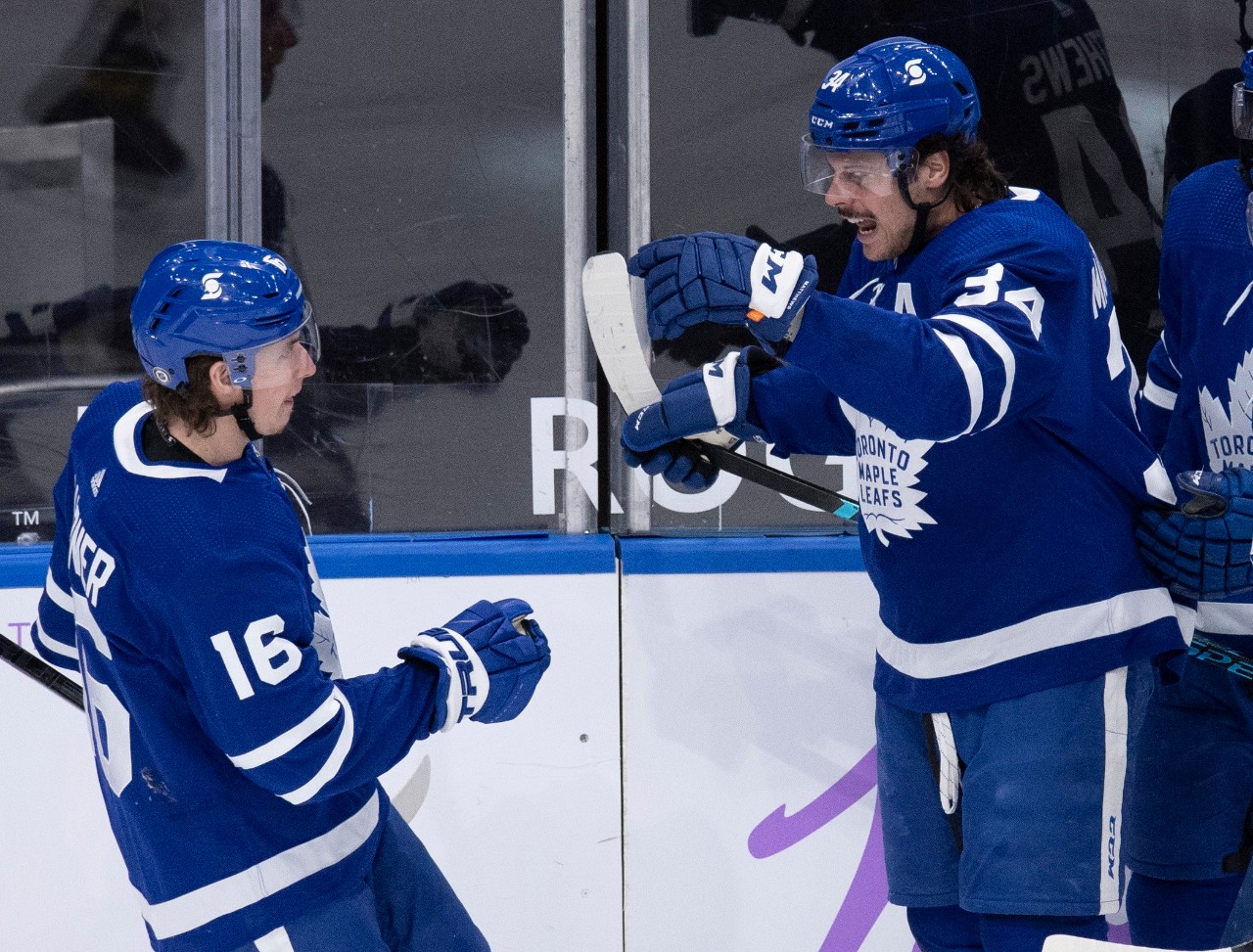In the 2018-19 playoffs, the Toronto Maple Leafs were eliminated, yet again, by the Boston Bruins in a seven-game series. Despite Auston Matthews playing over 20 minutes in four of those seven games, his ice time really came into question after logging 18:48 in Game 7, which was third on the team behind John Tavares and Mitch Marner.
Over his first three seasons, despite being one of the best goal scorers in the league from the moment he entered it, Matthews averaged 17:38, 18:08, and 18:33 of ice time, respectively.
The ice time for the Leafs’ young stars — particularly Matthews — became a major talking point for months carrying over into the next season. Ultimately, Mike Babcock was fired, Sheldon Keefe was hired, and Keefe immediately made it known that he planned to give the team’s top two young players, Matthews and Marner, as much ice time as they can humanly handle. Fans rejoiced, their minutes shot up, they lit up the scoresheet, and the team continued to lose in the first round of the playoffs, only this time to lesser opponents they were favoured against.
The performance of their top two star players, in particular, has come under heavy scrutiny in recent months. Over the past two playoffs, Marner does not have a goal to his name, although he does have eight assists over those 12 games. Matthews has three goals over the same 12 games — although, again, he has put up 11 points. While some of the criticism is fair, you would swear Matthews went pointless through 12 with the way it is talked about at times.
That said, while both players can certainly be better – Matthews, arguably the best goal scorer in the world, has three goals in his last 12 playoff games! – it is also worth considering whether the Leafs are simply asking too much of their top two players. Further, by uniting them on the same line, are they making themselves too one-dimensional in the process?
Let’s investigate further.
Over the past two playoff series, Matthews has averaged 24:42 of ice time per game and Marner has averaged 24:21. It is also worth noting that Zach Hyman averaged 22:04 over these 12 games as well. Against Columbus, Matthews played over 22 minutes in every game. While the John Tavares injury likely resulted in a slight uptick in his time on ice, the number was clearly going to be quite high regardless.
Earlier this offseason, I looked into how the final eight teams in the playoffs, plus the Leafs, are allocating their money at forward. In a nutshell, the Leafs spend more than anyone on their top six and less than everyone else on their bottom six.
This time, I was curious about how Cup winners have allocated their ice time. I used Natural Stat Trick to look up the most common line combinations of every Cup winner since the Blackhawks won in 2009-10 and charted out the ice time of each individual player to see how minutes were spread out.
Let’s look at the Leafs forwards by ice time as a starting point:
| LW (total toi/ev toi) | C (total toi/ev toi) | RW (total toi/ev toi) |
|---|---|---|
| 22:51 / 17:29 | 23:53 / 19:27 | 24:43 / 18:19 |
| 11:33 / 11:33 | 17:11 / 13:38 | 18:21 / 14:59 |
| 13:22 / 12:04 | 12:01 / 11:44 | 12:15 / 10:12 |
| 10:51 / 7:56 | 14:11 / 12:31 | 11:44 / 9:28 |
Obviously, the ice time is really loaded up at the top of the lineup. While the results were absolutely impacted by the John Tavares injury, it should be noted that Alex Kerfoot played over 17 minutes in three out of 56 games this season before averaging 17:11 in the playoffs. The contrast in how the Leafs allocated ice time compared to the last playoff is eye-opening.
Against Columbus, eight forwards averaged over 15 minutes per night, but against Montreal, only five did. Every regular Leafs forward averaged at least 10 minutes per night this year – last year, both Spezza and Kyle Clifford averaged under nine minutes per game in the playoffs.
For context, in the 2020 playoffs, the Leafs had five forwards average over 20 minutes per game (Matthews, Marner, Tavares, Hyman, Nylander), and a third line that played a notable amount, leaving the bottom line with minimal ice time.
In the 2021 playoffs, the Leafs loaded up the top line heavily, had two-thirds of a second line, and the bottom six was generally low in ice time across the board, with each line moving up or down depending on the game situation and player performance. Both lines essentially played fourth-line ice time. The 14:11 TOI figure belonged to Nick Foligno, who started in the top six and moved around due to an injury impacting his play.
Let’s compare this to the last 12 Cup winners. Instead of charting out the ice time allocation of 12 teams and making this unnecessarily long, I decided to jot out some observations:
– The simplest place to start is at the top. The highest average time on ice per game figure among Cup-winning forwards over the past 12 years belongs to Anze Kopitar, who averaged 22:03 per game when the Kings won their first of two Cups. That Kings team took only 20 games to win the Cup (Kopitar put up 20 points), winning the first three games of all four of their playoff series. Three of the Leafs’ forwards averaged more than any single Cup-winning forward per game, which is clearly unsustainable — and if we’re being honest, at least two of those players are not close to being as dominant of a two-way force as Kopitar was at that time.
– Now, there were a few teams with multiple forwards averaging more than 20 minutes a night the entire playoffs – the 2012 Kings also played Dustin Brown 20:44 per game, the 2013 Blackhawks had Toews and Kane, the 2015 Blackhawks played Toews, Kane, and Saad average 20+, the Capitals had four players over 20 per night (Ovechkin, Kuznetsov, Backstrom and Oshie), and there was the 2020 Lightning with Kucherov, Palat, Point and Cirelli. It is possible to have a “big 4,” so to speak, average big minutes and carry a team to championship success.
– But how did these teams make it possible? A few extra players who could handle average-to-above-average minutes. Six Leafs forwards averaged more than 14 minutes per game this past playoff – Hyman, Matthews, Marner, Kerfoot, Nylander, and Foligno, and Foligno was really of a shell himself playing on an injury (while he may have logged the time, it wasn’t impactful — a pointless four games in those minutes). The past 12 Cup winners averaged eight players playing over 14 minutes per game, and no team had lower than seven players average that benchmark and win the Cup.
It might not sound like a big deal – a few minutes here or there – but it’s generally the difference between a very good player making an impact and a player eating some minutes like a Colin Fraser on LA or Joe Thornton on Toronto.
– In theory, the Leafs have added another player to that group in Jared McCann, and they will be getting John Tavares back, but they’re likely losing Zach Hyman in free agency and either McCann or Kerfoot to expansion, so they are netting out relatively even. They still lack an impact forward or two that they can trust to take a regular shift.
– In the previous year against Columbus, the Leafs did have the depth of players they could have trusted — in theory — but the Andreas Johnson injury hurt them and they essentially punted it come crunch time in order to unite Tavares – Matthews – Marner as a line. Again, they made themselves a one-dimensional team while forcing Nylander to play clean-up duty.
– At even strength, the Leafs’ top line all averaged over 15 minutes per game at even strength, while nobody else on the team did. This is not unheard of – over the past 12 years, the average Cup winner had 3.25 players do this. The highest were the 2020 Lightning with eight players in this range (that’s a lot! Nobody else had more than five), and the Penguins and Kings each won one of their two recent Cups with only one forward each averaging that (Kopitar and Crosby were the two, by the way).
The difference, of course, is the special teams ask — especially for Mitch Marner, who plays heavily on both the power play and shorthanded units. Marner is a really good player, but they are essentially asking him to be the best player in the world – play more than basically anyone, lead the penalty kill, and also run the power play. Saying it’s a lot is underselling it — this is unfair, and in part, this is what leads to some of the criticism of the player of late. He is a legitimate star, but the weight and depth of responsibility on his shoulders is overbearing.
– Teams have won a Cup while essentially reducing their fourth line to minimal use at best. The Kings won with a fourth line of Brad Richardson, Colin Fraser, and Jordan Nolan, the Bruins played Dan Paille under nine minutes a night and Shawn Thornton under seven, and the Blackhawks won with Ben Eager playing six minutes a night and Adam Burish playing roughly five and a half. In theory, it’s possible, but those examples all came about 10-plus years ago now.
The last nine Cup-winning teams have combined to have just one player average under 10 minutes a night and win the Cup – Pat Maroon, in the bubble, averaged 9:25. The emphasis on depth and meaningful minutes throughout the lineup is generally growing.
– Where the Leafs really stand out is on the third line. For our sake here, we’re calling it Mikheyev – Engvall – Simmonds, as this was their third line with the season on the line. None of these players hit that 14-minute per game mark — in part because none of them were impactful enough to earn that ice time, with the three combining for zero goals in the playoffs.
The only team I investigated with a third line where nobody averaged 14+ was, arguably, the 2013 Blackhawks, who ran a third line of Kruger – Bolland – Frolik. That said, they had a “fourth” line of Bickell – Shaw – Stalberg, and two of those three averaged 14+, so perhaps they were simply the third line on a stacked team that also had Saad, Toews, Hossa, Kane, Sharp, and Handzus and were moving players around as they saw fit.
– This is another common theme among Cup winners: multiple players in the bottom six who can easily move up to the top six. All things being on equal, on most other teams, these players would straight up play in their top six. The Leafs were likely lacking a body in this department – although Kerfoot did successfully move up in this past playoff. Galchenyuk is clearly a Jekyll-and-Hyde player at this point, and the 11:33 he played per night reflected that. Spezza has shown he can still produce at a high level, but the team has appeared to unilaterally decide that he is only able to play about 11 minutes and change, give or take, each night. The rest of the bottom six lacked options, particularly scoring options.
Again, an extra player or two of significance would drastically alter the makeup and ice time allocation of the forward group. It sounds trivial — not the big thing that people think they need to push them over the hump — but the hardest thing to do in the league is to acquire and retain star players. The Leafs have done this, and while they need more from them at playoff time, they need a bit more around them, too. You can’t ask four players to line up against and outplay the other elite teams’ top six while also making up for the scoring difference for a third line that can’t produce at all and a fourth line that boils down to, “Did Jason Spezza score today?”
– It should also be noted that a common theme among most of these teams is good health. Many of them only dressed 13 or 14 forwards total, and those bottom few forwards only played a game or two throughout an entire Cup run. There would have been differences had Tavares not gotten injured, and teams rarely win despite one of their top players getting hurt. Tampa Bay did win largely without Stamkos, but it should be noted he played in this year’s playoffs and was ninth among their forwards in average time on ice per game.
Ultimately, the easiest way to flatten out the ice time a bit is to just add better players across the board. Failing that – and they would need to bring in multiple notable players at this point under a tight cap, as they are likely losing Hyman and one of Kerfoot/Jared McCann – they have to consider spreading out the wealth a little bit. The Penguins did this by giving each of Crosby, Malkin, and Kessel their own line, Chicago did this by putting Toews (in fairness, he was with Hossa), Kane, and Sharp on separate lines, and the Kings placed Kopitar, Carter, Williams, and Richards on different lines in their second Cup win. It is not unheard of.
What is unheard of, in this era of the NHL, is loading up three or so forwards with extremely high minutes and expecting to win the Cup. Compounding matters for the Leafs is that the three forwards all play on the same line. It doesn’t feel like innovation or a case of the first through the wall getting the bloodiest. It feels like it’s a case of being different for the sake of being different at this point.
It’s fair to say that Matthews and Marner have come up short in the playoffs. They could have played better, and they need to learn from it. But if the coaching staff is looking themselves in the mirror and being honest, they didn’t set them up for success, either.

































